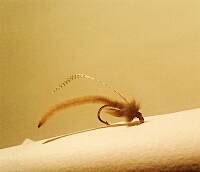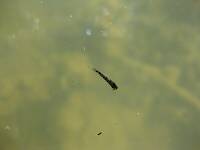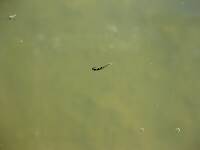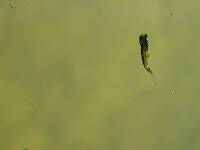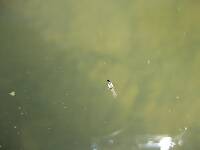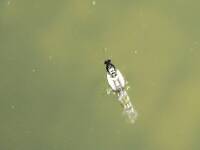
Salmonflies
Pteronarcys californica
The giant Salmonflies of the Western mountains are legendary for their proclivity to elicit consistent dry-fly action and ferocious strikes.
Featured on the forum

Troutnut is a project started in 2003 by salmonid ecologist Jason "Troutnut" Neuswanger to help anglers and
fly tyers unabashedly embrace the entomological side of the sport. Learn more about Troutnut or
support the project for an enhanced experience here.
Goose
Posts: 77
Posts: 77
Goose on Oct 19, 2006October 19th, 2006, 1:44 am EDT
Do you guys think that La Fontaine's Deep Sparkle Pupa and Emergent Sparkle Pupa Caddis patterns in different colors would be all one would need to cover a caddis hatch? I realize there are other patterns out there but do you think these styles would suffice? Thanks. I'm sure getting to the root of what I want to learn about caddis. I'm trying to simplify my approach and cut down on the number of patterns I carry around.
Troutnut on Oct 19, 2006October 19th, 2006, 6:14 am EDT
All one would need? No. But if you could only carry two, they would probably be good choices.
Remember that you need to match caddis egg-laying activity, too, not just the emergence. So you should definitely add a dry adult and a diving adult to the overall mix for caddisflies.
I prefer to have patterns in a few different styles, just in case the one I know should be working does not. Of course, that goes against the idea of simplifying...
Remember that you need to match caddis egg-laying activity, too, not just the emergence. So you should definitely add a dry adult and a diving adult to the overall mix for caddisflies.
I prefer to have patterns in a few different styles, just in case the one I know should be working does not. Of course, that goes against the idea of simplifying...
Jason Neuswanger, Ph.D.
Troutnut and salmonid ecologist
Troutnut and salmonid ecologist
Goose
Posts: 77
Posts: 77
Goose on Oct 19, 2006October 19th, 2006, 6:39 am EDT
Right, Jason. I carry the adults, but I've never fished egg-layers so I imagine I should tie some divers, too! Thanks! It's so hard to simplify. Ha! Ha!
GONZO on Oct 19, 2006October 19th, 2006, 7:15 am EDT
No and yes. Gary certainly presented those patterns as if they were universal solutions in Caddisflies, but they are not. (I won't bother you with the "why" unless you want me to.) And yes, the patterns are certainly effective, especially for the most important species (which are ones that emerge on the surface).
One of the most important things to keep in mind in your quest to uncomplicate the caddisfly puzzle is that two families present the best and most common opportunities for fly fishing during an emergence--Hydropsychidae (Spotted Sedges/Little Sister Sedges) and Brachycentridae (Grannoms). Any caddisfly that the fish are feeding on while you are fishing can be important, but these two families often comprise the bulk of that action.
As a further means of simplification, consider tying only an unweighted version of the Deep Sparkle Pupa. With weight on the leader, it can be dead-drifted prior to the surface action. It can be fished with a "Leisenring Lift" or swung wet-fly style as the pupae are rising to the surface. And it can be fished behind a dry adult when fish are feeding on the surface. (In this case, most of the action will be to the pupa, with the dry acting primarily as an "drift-tracking device" or indicator.)
To continue the simplification theme, tie all of the overbodies with clear Antron rather than the colored sparkle yarn Gary recommended. This way, you won't need to locate all the matching overbody colors. I would also recommend making the overbody tighter and sparser than shown in Caddisflies. This makes the tying a little easier and is just as effective.
Finally, out of respect for Softhackle and others who have a completely justifiable affection for soft-hackled flies, don't discount these as viable options. I like them for imitating smaller species and they can have an edge over Gary's patterns during the swimming-to-the-surface phase of a caddisfly emergence (because they imitate the pulsing movement of the caddisfly's legs as it swims, which can be an important trigger). You might want to compromise by using a version of Gary's body and soft-hackle for legs.
One of the most important things to keep in mind in your quest to uncomplicate the caddisfly puzzle is that two families present the best and most common opportunities for fly fishing during an emergence--Hydropsychidae (Spotted Sedges/Little Sister Sedges) and Brachycentridae (Grannoms). Any caddisfly that the fish are feeding on while you are fishing can be important, but these two families often comprise the bulk of that action.
As a further means of simplification, consider tying only an unweighted version of the Deep Sparkle Pupa. With weight on the leader, it can be dead-drifted prior to the surface action. It can be fished with a "Leisenring Lift" or swung wet-fly style as the pupae are rising to the surface. And it can be fished behind a dry adult when fish are feeding on the surface. (In this case, most of the action will be to the pupa, with the dry acting primarily as an "drift-tracking device" or indicator.)
To continue the simplification theme, tie all of the overbodies with clear Antron rather than the colored sparkle yarn Gary recommended. This way, you won't need to locate all the matching overbody colors. I would also recommend making the overbody tighter and sparser than shown in Caddisflies. This makes the tying a little easier and is just as effective.
Finally, out of respect for Softhackle and others who have a completely justifiable affection for soft-hackled flies, don't discount these as viable options. I like them for imitating smaller species and they can have an edge over Gary's patterns during the swimming-to-the-surface phase of a caddisfly emergence (because they imitate the pulsing movement of the caddisfly's legs as it swims, which can be an important trigger). You might want to compromise by using a version of Gary's body and soft-hackle for legs.
Quick Reply
Related Discussions
Topic
Replies
Last Reply
1
Jan 10, 2012
by Doublespey
by Doublespey




